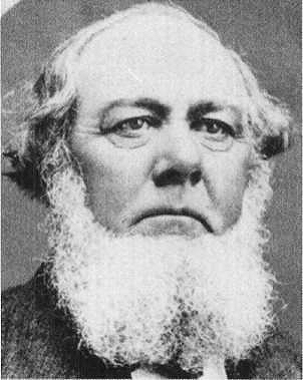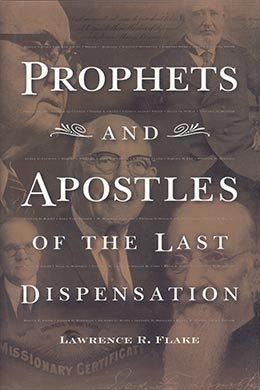Charles Coulson Rich
Lawrence R. Flake, Prophets and Apostles of the Last Dispensation (Provo, UT: Religious Studies Center, Brigham Young University, 2001), 391–94.

Born: 21 August 1809, Campbell County, Kentucky
Quorum of the Twelve Apostles: 12 February 1849 (age 39)
Died: 17 November 1883 (age 74), Paris, Idaho
Apostle Charles C. Rich was leading a group of missionaries across the desert to California—some to explore the area for settlement and some assigned to dig gold and bring financial aid to the Church. A company of gold seekers led by Captain John Smith persuaded the missionaries under Brother Rich to take a shortcut that would supposedly save them days of travel.
After the group nearly perished for want of water, Brother Rich felt impressed that he must take the Mormon elders and turn back to the established route, even though they had wasted a good deal of time trying to cut across the Sierras. On 11 November 1849, Elder George Q. Cannon, a member of the party, recorded in his journal: “Bro. Rich said this evening that he was not going to be led round in this manner any longer. We should all parish in the mountains if there was not an alteration; . . . he should go back to the wagons as quick as he could. . . . It had been his mind to travel on the table land and keep out of the mountains, & if we could not go that way we could not go at all.” [1] The elders, knowing that the apostle was entitled to inspiration from the Lord, all turned back and arrived in California safely. The gold diggers, who tried to keep going, encountered near starvation before turning back. [2]
Brother Rich, an exemplary pioneer, possessed unusual physical stamina along with many spiritual qualities. Since his baptism in 1832, he took an active part in the progress of the restored Church. He traveled from Tazwell, Illinois, to Kirtland, Ohio, to meet the Prophet, and from there went on several missions, one being to his native state of Kentucky, where he was born 21 August 1809. In 1836 he moved to Far West, Missouri. In Caldwell County he married Sarah Pea, his first wife, who became the mother of nine of the fifty children he had under the sanction of plural marriage. [3]
During the difficulties in Missouri, Brother Rich was in the forefront of the Saints’ defense, being next in command to David W. Patten in the battle of Crooked River. When Brother Patten was mortally wounded in that battle, Brother Rich laid down his weapons and administered to him and then carried on as leader of the army, bringing the Saints to victory. Later, Captain Rich was in charge of some Latter-day Saint troops who were protecting the settlement of Far West. While Brother Rich was under the supposed protection of a white flag of truce, a Methodist minister, Samuel Boggart, who was leading the anti-Mormon forces, fired on him at close range, about twenty feet. But on this occasion, as on many others, the Lord protected Brother Rich, and his life was spared.
Because Elder Rich and other Latter-day Saint leaders were accused by the enemy of murder in regard to the Missouri difficulties, he was obliged to flee for his life and went to Quincy, Illinois. He moved his family to Nauvoo and from there participated in the exodus west, reaching Utah with his aged parents in 1847. His mother, whose greatest wish was to see the resting place of the Saints, died two days after their arrival and was the first member of the Church buried in the Salt Lake Valley.
Elder Rich was sent in 1849, with Elder Amasa Lyman, to explore California with the assignment to establish a colony of Latter-day Saints there. Finding a place to settle proved to be much more expensive than the two apostles anticipated. The only place they could find was the San Bernardino ranch, and they decided to purchase about 100,000 acres of it. Elder Rich said, “I will assure you . . . that I thought a great deal upon the subject before I undertook the burthen as I considered it; I prayed about it . . . and I could find nothing else, no other place so suitable, and consequently I with Bro. Amasa Lyman decided to take upon us the load, and the responsibility of purchasing San Bernardino.” [4] Elder Rich was made mission president, and the settlement thrived until the Saints residing there were called home to Utah in 1857 because of the invasion of the U.S. Army.
Following these difficulties, he was sent to preside over the British Mission and subsequently, in 1863, was sent to colonize Bear Lake Valley. He was a strong physical and spiritual force to the Saints there and forged ahead, making prosperous the settlements they established. He demonstrated his fortitude by making numerous trips on foot across miles of snow to obtain mail and attend the sessions of the legislature to which he had been elected. In 1880, at the age of seventy-two, Elder Rich was stricken with paralysis—an agonizing situation for one of his former vigor, but he bore it all cheerfully and without complaint until his death in 1883. Brother Matthias Cowley described his life in these words: “He was a man of great moral and physical stamina. He had the courage of his convictions, not merely the courage to face the foe in sanguinary conflict upon the battlefield, but the grander kind which caused him to act upon the right against the popular sentiment of a frowning world.” [5]
Notes
[1] George Q. Cannon, Journal, 11 November 1849, LDS Church Archives.
[2] George Q. Cannon “Twenty Years Ago,” Juvenile Instructor, 8 May 1869, 79.
[3] John Henry Evans, Charles Coulson Rich: Pioneer Builder of the West (New York: Macmillan Company, 1936), 105.
[4] Leonard J. Arrington, Charles C. Rich: Mormon General and Western Frontiersman (Provo, UT: Brigham Young University Press, 1974), 165.
[5] Matthias F. Cowley, Prophets and Patriarchs of the Church of Jesus Christ of Latter-day Saints (Chattanooga, TN: Ben E. Rich, 1902), 217. See also Andrew Jenson, Latter-day Saint Biographical Encyclopedia (Salt Lake City: Andrew Jenson History, 1901), 1:102–3.
